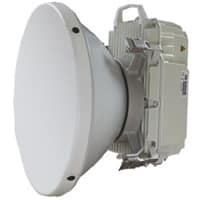E-band microwave technology refers to the utilization of electromagnetic waves in the millimeter-wave frequency range, specifically in the E-band spectrum. This spectrum ranges from 71 to 76 GHz and from 81 to 86 GHz. It is commonly employed for establishing high-capacity point-to-point wireless communication links.
The advantages of E-band microwave technology are numerous. Firstly, it offers high data throughput, allowing for the transmission of large amounts of data at rapid speeds. Additionally, it provides low latency, ensuring minimal delay in data transfer. E-band microwave technology also boasts a compact antenna size, making it suitable for installations with limited space. Moreover, the spectrum availability of E-band frequencies is often favorable, as they are typically lightly licensed or even license-exempt in many countries. This makes it easier and more cost-effective to deploy E-band links. While E-band has a shorter range compared to traditional microwave bands, it generally offers a longer range than Wi-Fi, making it well-suited for point-to-point links over greater distances.
Despite its advantages, E-band microwave technology does face certain challenges and limitations. One limitation is the limited range due to higher atmospheric attenuation and vulnerability to rain fade compared to lower-frequency microwave bands. This restricts the range of E-band links, making them more suitable for shorter distances. Additionally, E-band signals are highly directional and require a clear line of sight between antennas. Obstacles such as buildings, trees, or physical structures can obstruct or degrade the signal, limiting deployment options. Furthermore, E-band microwave equipment tends to be more expensive than lower-frequency microwave systems due to the need for specialized components to operate in the millimeter-wave frequency range.
Practical applications of E-band microwave technology include its use as backhaul for cellular networks, providing high-capacity, low-latency connections between mobile network base stations and core networks to support data-intensive services. It is also utilized in fixed wireless access, enabling high-speed internet connections in areas where deploying fiber-optic cables may be challenging or costly. E-band microwave technology finds applications in campus or enterprise connectivity as well as video surveillance and security systems.
In terms of emerging trends and advancements, E-band microwave technology is witnessing the adoption of enhanced modulation techniques such as quadrature amplitude modulation (QAM) to increase data capacity and spectral efficiency. Multi-gigabit solutions are also being developed to support high-capacity links, facilitating the transmission of large volumes of data at ultra-high speeds. Moreover, there is a growing trend of integrating E-band with other wireless technologies like Wi-Fi and 5G to create hybrid solutions that leverage the strengths of different frequency bands for diverse applications. Additionally, improved antenna technologies such as beamforming and electronically steerable antennas are being developed to enhance E-band link performance, extend the range, and mitigate interference.
Benefit from Massive discount on our 5G Training with 5WorldPro.com
Start your 5G journey and obtain 5G certification
contact us: contact@5GWorldPro.com


